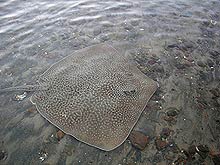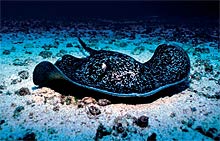Stingrays are bottom dwelling rays and their pectoral fins are ideally adapted to burying in sand or mud. The pectoral fins of pelagic rays, such as eagle rays and mantas, are more wing-like with strong muscles for prolonged swimming. These pelagic rays seem to literally ‘fly’ through the water.
Distribution
Rays are found throughout the oceans, from the tropics to the cold waters around the Arctic and Antarctica. They are also found at all depths, from the intertidal zone down to the deep sea. While most rays live in the sea, a few also live in fresh water; some up to thousands of kilometres inland in South America.
Their wide distribution and diversity means that rays have an important role in almost all marine ecosystems, with each species having its own distinctive niche.
The ocean is a three-dimensional environment, with underwater habitats structured both vertically and horizontally. Almost all rays feed on prey living close to, on, or just underneath the bottom. They act somewhat like the vacuum cleaners of the ocean.
This means that the animals that feed on them live on the bottom as well. Rays feed mainly on invertebrates and small vertebrates, with prey ranging from quite large fish down to tiny crustaceans. All known rays are carnivorous, and as a group they are high in the food web. |

A tropical whipray (Himantura sp.)
(© Shane Litherland)

A typical encounter with a large ray,
swimming close to the
seafloor.
(© Andrea Marshall)
|
